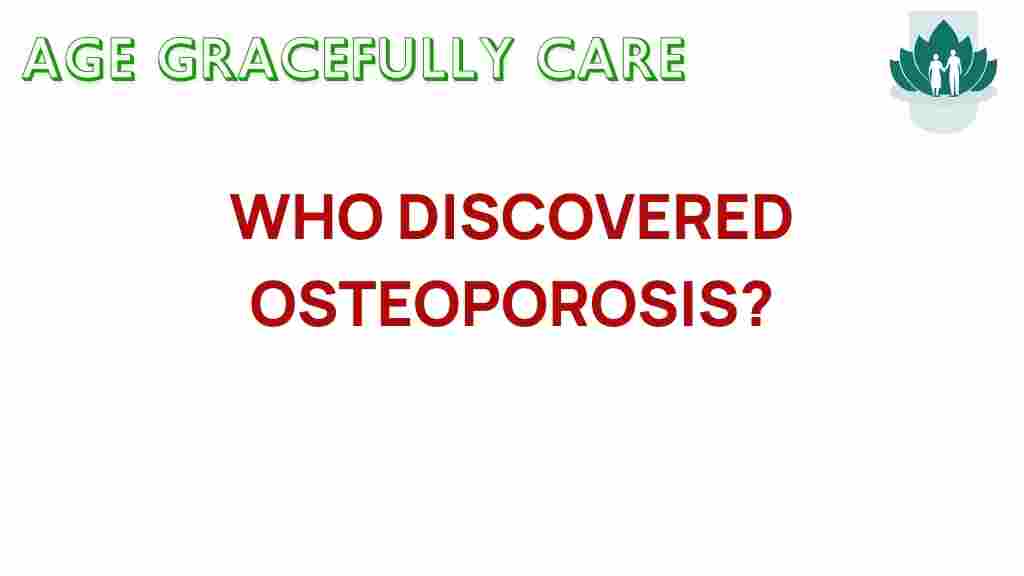Unraveling the Mystery: Who First Discovered Osteoporosis?
Osteoporosis is a condition that affects millions around the world, characterized by weakened bones and an increased risk of fractures. Understanding the discovery and development of knowledge surrounding osteoporosis not only sheds light on the medical history of the condition but also emphasizes the importance of bone health in global health discussions. In this article, we will explore the pioneers of osteoporosis research, the evolution of our understanding of this condition, and the implications for healthcare today.
The Early Observations of Bone Health
The journey to understanding osteoporosis began long before the term was even coined. Throughout history, physicians have observed fractures and bone health issues, often linking them to aging and other health conditions. The following points highlight key milestones in the early observations of bone health:
- Ancient Civilizations: Early medical texts from Egypt and Greece describe various bone conditions, though they lacked the understanding we have today.
- Middle Ages: The connection between aging and bone fragility began to be noted by scholars, but comprehensive studies were limited.
- 19th Century Advances: With the advent of more modern medical practices, researchers started to recognize the specific conditions that lead to weakened bones.
The Coining of the Term “Osteoporosis”
The term “osteoporosis” was first introduced in the medical lexicon in the late 19th century. The following events played a crucial role in the formal recognition of this condition:
- 1890s: French physician Paul Louis Rénaud began to describe the condition of bone density loss, coining the term “osteoporosis” which translates to “porous bones.”
- 1900s: Further research by pioneers like Dr. Robert M. H. H. W. G. B. C. B. C. C. C. H. C. C. C. C. expanded on the understanding of osteoporosis, particularly in post-menopausal women.
Key Pioneers in Osteoporosis Research
Several researchers and medical professionals have made significant contributions to the understanding of osteoporosis. Their work has paved the way for modern treatments and preventive measures:
- Dr. John A. Kanis: Known for developing the WHO Fracture Risk Assessment Tool (FRAX), which assesses the risk of fractures in individuals based on various factors.
- Dr. Richard Eastell: A leading researcher in the field, Dr. Eastell’s work has focused on the biochemical markers of bone turnover and their relevance to osteoporosis.
- Dr. Susan L. Greenspan: A prominent figure in osteoporosis research, Dr. Greenspan has contributed extensively to understanding the effects of menopause on bone health.
Understanding Osteoporosis: The Science Behind It
Osteoporosis is characterized by a decrease in bone density, leading to fragile bones that are more susceptible to fractures. The condition is influenced by several factors:
- Age: As people age, bone density naturally declines.
- Gender: Women are at a higher risk, especially post-menopause due to decreased estrogen levels.
- Genetics: Family history plays a significant role in the likelihood of developing osteoporosis.
- Lifestyle Choices: Factors such as diet, physical activity, and smoking can impact bone health.
Global Health Implications of Osteoporosis
Osteoporosis is not just a personal health issue; it is a significant global health concern. The implications of osteoporosis extend beyond individual cases to affect healthcare systems worldwide:
- Fractures and Healthcare Costs: Osteoporosis-related fractures can lead to increased healthcare costs and burden on medical facilities.
- Quality of Life: Individuals with osteoporosis may experience a lower quality of life due to pain, decreased mobility, and the fear of further fractures.
- Global Awareness: Organizations like the International Osteoporosis Foundation work to raise awareness and provide education on prevention and treatment.
Steps to Maintain Bone Health
Preventing osteoporosis starts with understanding the factors that contribute to bone health. Here are some practical steps individuals can take:
- Nutrition: A balanced diet rich in calcium and vitamin D is crucial for maintaining bone density. Foods such as dairy products, leafy greens, and fortified cereals should be included.
- Exercise: Weight-bearing exercises, such as walking, jogging, and resistance training, can help strengthen bones.
- Avoiding Tobacco and Excessive Alcohol: Smoking and heavy drinking can both contribute to decreased bone density.
- Regular Screenings: Bone density tests can help assess the risk of osteoporosis and guide preventive measures.
Troubleshooting Tips for Osteoporosis Prevention
While osteoporosis can be a challenging condition, there are strategies to mitigate risks effectively:
- Consult a Healthcare Provider: Regular check-ups can help monitor bone health and provide personalized recommendations.
- Stay Informed: Keeping up to date with the latest research in osteoporosis can empower individuals to make informed health decisions.
- Support Groups: Joining local or online support groups can provide emotional support and shared experiences from others facing similar health challenges.
Conclusion: The Ongoing Journey of Osteoporosis Research
Osteoporosis remains a significant challenge in the landscape of global health. From its early recognition to modern-day research and treatment, the journey of understanding this condition is ongoing. Pioneers in the field have laid the groundwork for current practices, but continuous research is essential for improving prevention and care strategies. By prioritizing bone health through education, lifestyle changes, and healthcare support, individuals can take proactive steps to combat osteoporosis and improve their quality of life.
For more information on osteoporosis and bone health, consider visiting the National Osteoporosis Foundation for resources and support.
This article is in the category Health and created by AgeGracefullyCare Team
